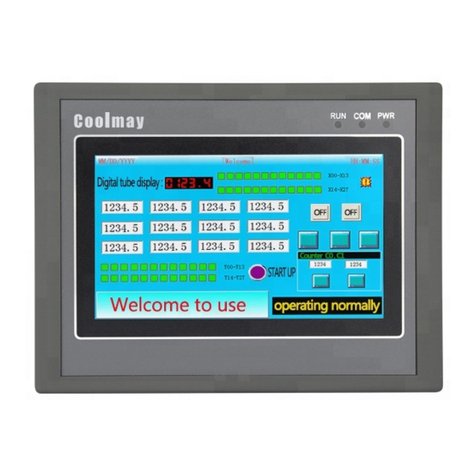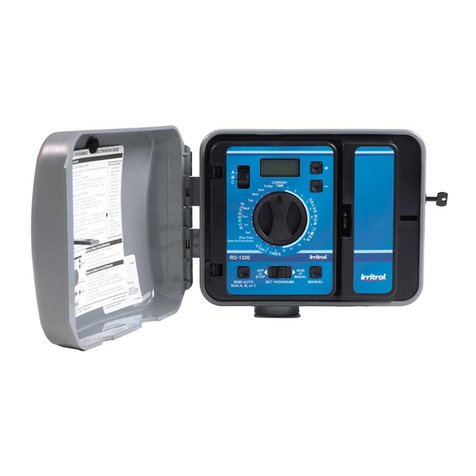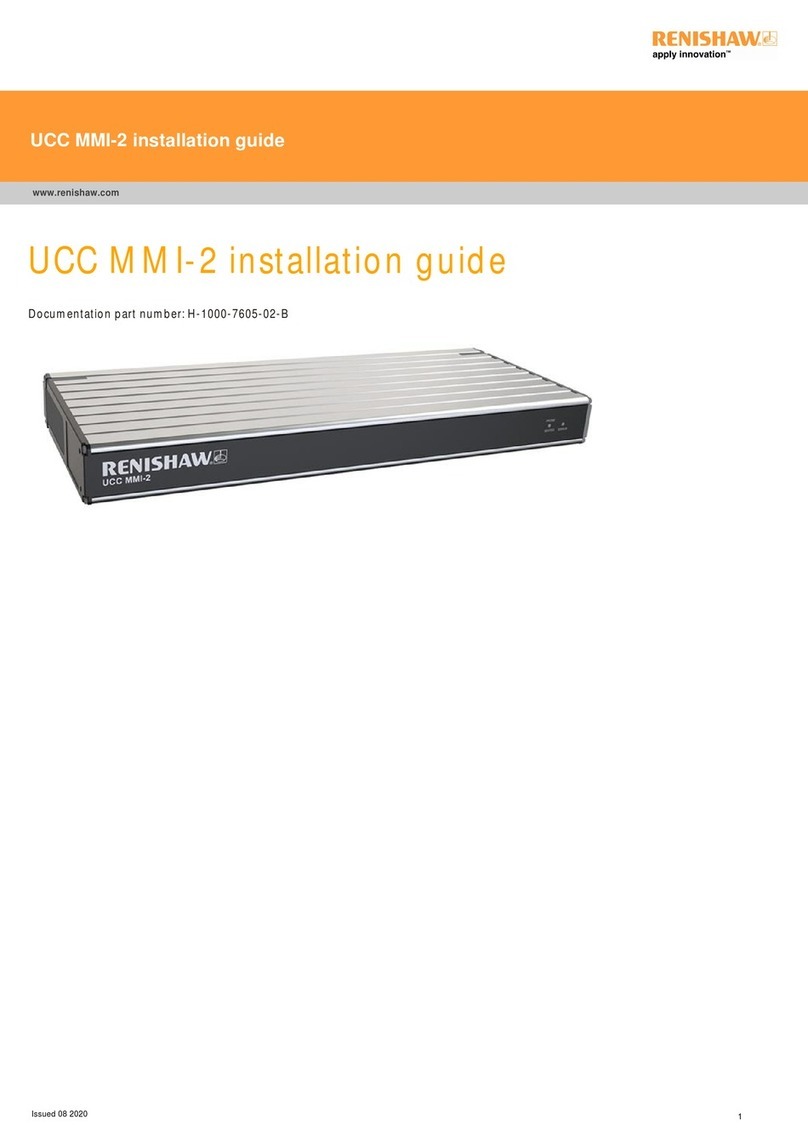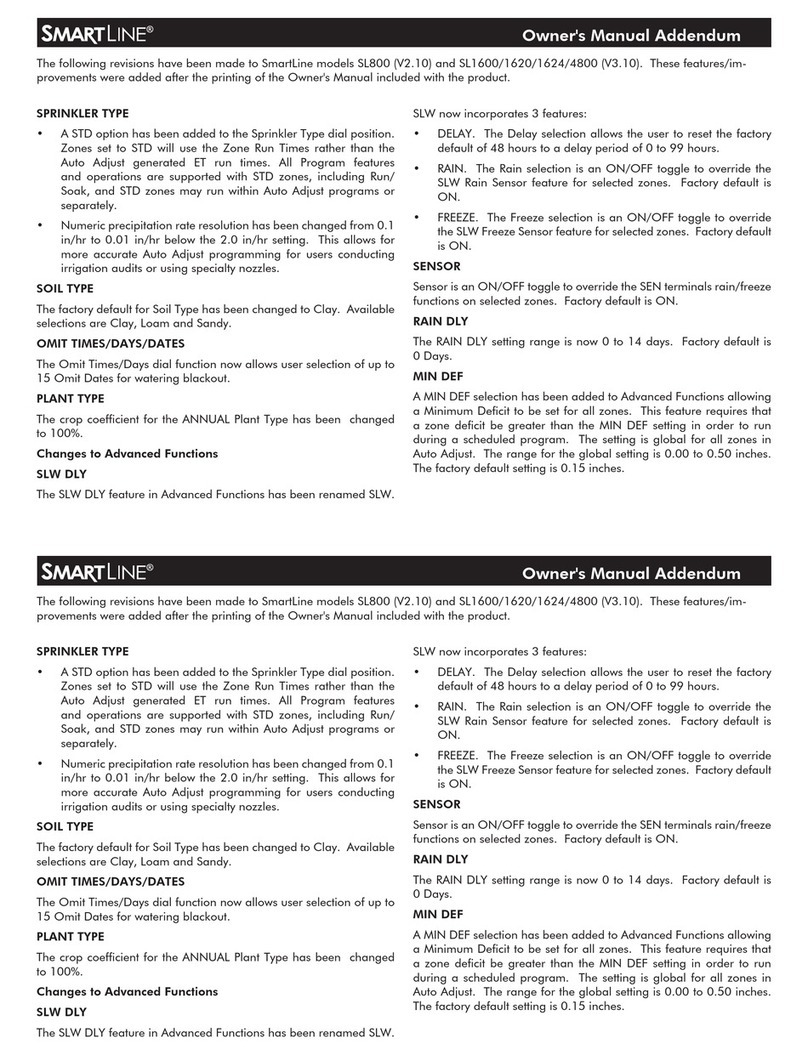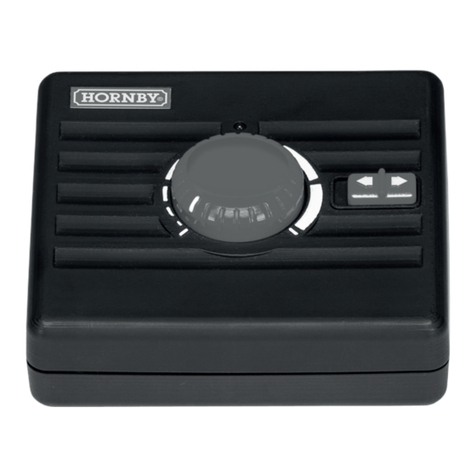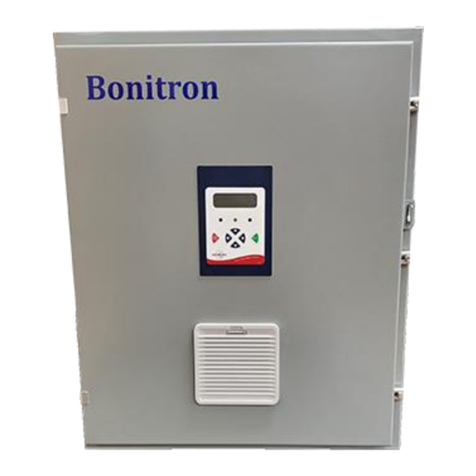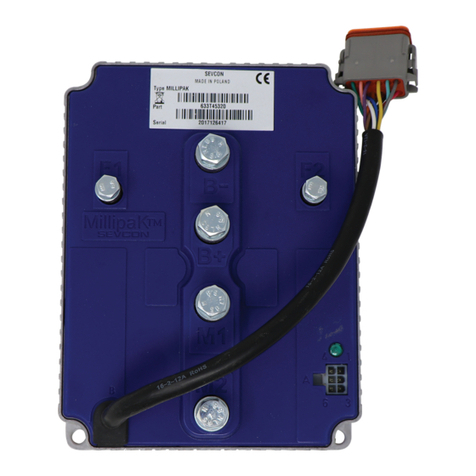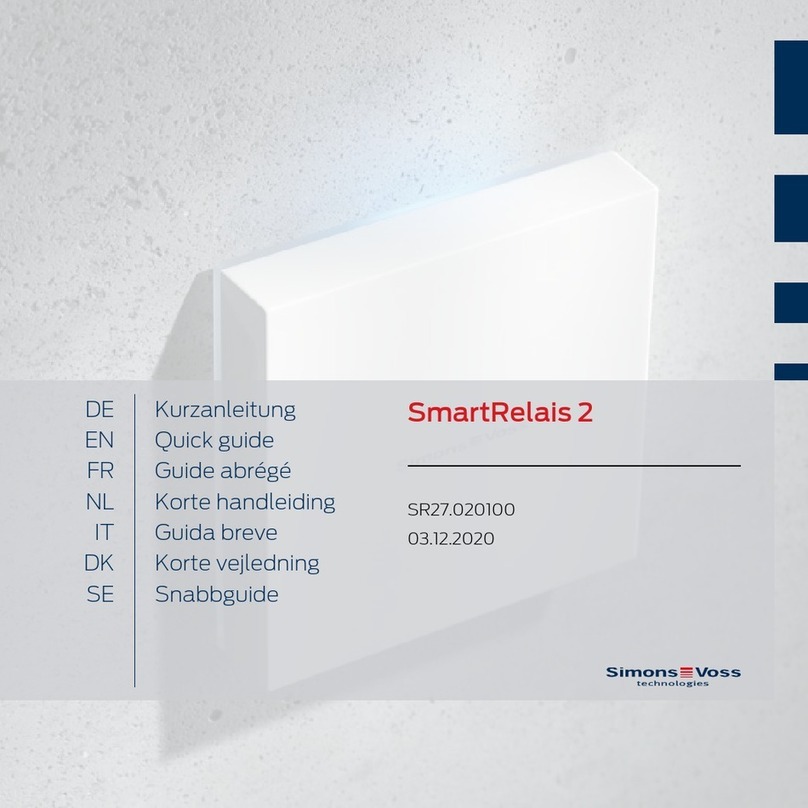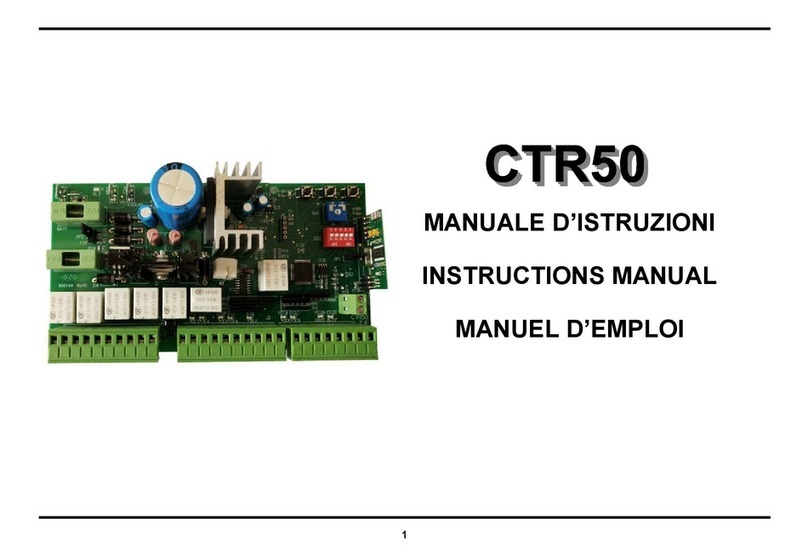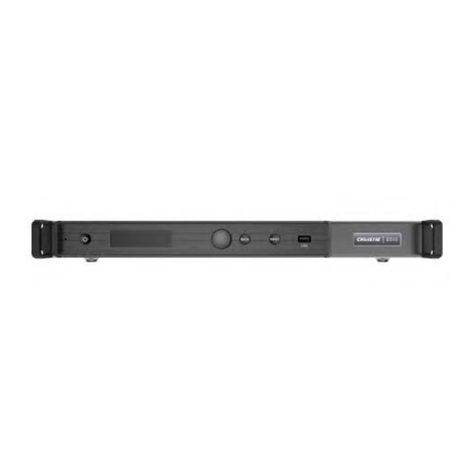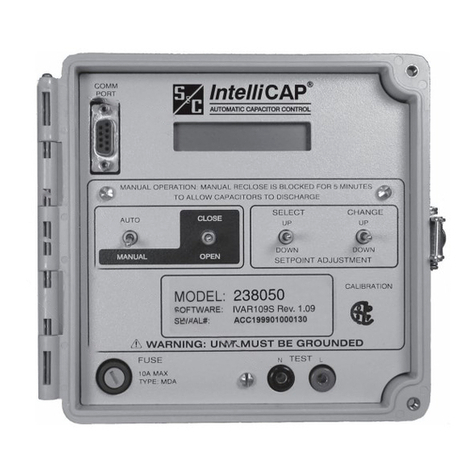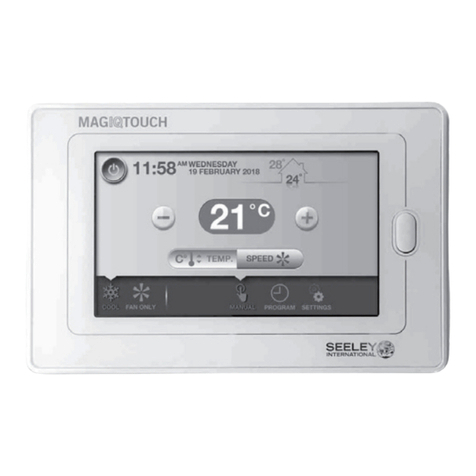TIANJIN BAILI ERTONG MACHINERY IMT Series User manual

(Please read this Operation Manual carefully before using this product.)
SM-20
IMT Series Intelligent Multi-turn Electric Valve Actuator
IMT Explosion-proof Series Intelligent Multi-turn Electric Valve
Actuator
Operation Manual
Tianjin Baili Ertong Machinery Co.,Ltd
(Former Tianjin No.2 General Machinery Plant)

Contents
Part I Machinery configuration and mounting…………………………………1
1. Summary
2. Major features
3. Main structure
4. Connection with valve
5. Lubrication
6. Electric wiring
7. Notice
Part II Set up and adjustment………………………………………………..…4
1. Local control
2. Operation instruction for actuator:
3. Adjustment for electric actuator
4.Function of electric acutuator and parameter setup
5. Alarm information
6. Referenced control wire connection
7. Referenced circuit diagram
Part III Additional Instruction for IMT-04~4Ex Explosion-proof product…..12
1.Summary
2. Notice for maintenance and usage
3. Wire outlet on wiring box
4. Wiring sequence
5.Other

1
Part I Machinery configuration and mounting
1. Summary
IMT series un-intrude intelligent multi-turn electric valve actuator (hereinafter referred to as electric actuator) is
used to operate with gate valve, globe valve, diaphragm valve and other valves whose discs make linear movement.
IMT combines with other reducers, so they become a combined multi-turn or quarter-turn electric actuator.
This Operation Manual is prepared for IMT standard type and IMTEx explosion-proof type. For other optional
function, additional instruction will be offered.
2. Major features
2.1 Power supply: 380V, 50Hz, three-phase three-wire sine AC (for other power supply voltage, please let be
informed)
2.2 Enclosure protection: IMT-04~2、IMT-04~2Ex: IP67(please let be informed, for IP68)
IMT-3~4: IP65
2.3 Ambient temperature: -20℃~+70℃(if it exceeds this range, please inform)
2.4 Ambient humidity: < 90%(at 25℃)
2.5 Altitude: < 1000m
2.6 Short-time duty: Rated time 10、15、30 min (according to the motor’s actual loading)
2.7 Without strong vibration.
2.8 Without strong corrosive material and explosive mixed gas.
2.9 Set-up methods: local selector switches, remote setter (please inform if remote setter is needed)
3. Main structure
Major components of electric actuator:
3.1 Valve special used motor: It conforms to valve’s loading performance and working condition. With a big
start-up torque, small rotational inertia and short-time duty.
3.2 Reducer: it is composed of first-class gear pair and first-class worm gear pair. It is used to transmit and enlarge
the input power of motor. Every seating No. of IMT and IMTEx series has 3-5 kinds of speed ratios for worm gear
pair, and numerous speed ratios for gear pair. Thus, it owns a practical output rotation speed range.
3.3 Output shaft (driving hollow shaft): it is the power-output component of electric actuator. Both jaw type and
valve stem nut type can be provided. The internal thread is usually processed by user. The type of the output shaft is
decided by user when ordering.
3.4 Manual-electric switching handwheel: it is used to switch manual operation between electric operation. It is
semi-automatic, electric-operation priority. Press the handle according to the arrow before manually operating;
gently turn the handwheel until the switching handle is finally rotated at the right place. Manual-electric switching
job is finished and manual operation starts. While it is electrically operated, switch the handle to the electric
operation position and it starts to work electrically.
(Note: it is forbidden to forcefully turn switching handle from manual operation position to
electric operation position, otherwise actuator would be damaged.)
3.5 Manual operation mechanism (handwheel): use handwheel after manual-electric switching is finished. The
handwheel of IMT-04~03(IMT-04~03Ex) is on the top of the actuator, so it directly drives the output shaft during
manual operation. The handwheel of IMT-00~2(IMT~2Ex)、IMT-3~4 is on the side of the actuator, so the
handwheel directly drives output shaft through worm gear pair.
3.6 Torque control mechanism: it controls output torque and protects electric actuator from over-loading and being
jammed.
The working schematic for IMT series output torque: axial force from worm gear acts on Belleville spring, and it
drives torque switch to finish torque control. User is forbidden to adjust the torque value which is locked and
required by user before factory delivery.
3.7 Limit control mechanism: it is used to precisely control valve’s end position and used to feedback valve position

2
signal. It is composed of middle transmission mechanism, absolute encoder, integrated circuit board, and etc... It
records and processes the rotation turns of output shaft to have valve controlled. Use selector switch and remote
setter to set up actuator after it has been connected with valve, so that a precise limit position and required valve
position feedback are acquired.
3.8 Position indicator: it is used to show valve position, torque and other functions.
3.9 Local selector switch: it is used to set up and operate electric actuator on site.
3.10 Wiring terminal case: it is used for wiring on site. Double-sealing structure is good for actuator’s outdoor
performance.
4. Connection with valve
Preparation before connection:
*Before connection, check if the type and size of the flange of valve and actuator are the same, so as to ensure
the two can connect correctly.
*For the actuator using stem nut, process internal thread of the stem nut to have it connected with valve correctly.
*Clean valve stem and apply grease.
*For rising stem valve, make sure the external part of the valve stem is shorter than the height of the stem cover
of actuator.
*Be care of the mounting position of the actuator against pipe to have enough dismantle space or adjusting space
for actuator.
*There’s no special requirement on actuator’s working position, but motor’s axial level and be vertical to the
selector switch are preferred. This is good for product lubrication, maintenance and check up on site.
4.1 The connection between valve and actuator with stem nut
Put the processed the stem nut into output shaft, and using locking nut to axially fasten it. Sling actuator to make
the internal thread of stem nut to be aligned with valve stem. Manually operate actuator to make the valve open (the
standard rotation direction of stem thread is left, and the output shaft will rotate counterclockwise). Gradually pull
down actuator; as valve stem meshes with stem nut, actuator flange begins to touch valve’s connection surface.
Screw bolt into the flange thread hole and keep the bolt firmly.
To keep stem nut firmly setting in output shaft, user could use cutting tools to damage the meshing fringe
between the upper part of output shaft and locking nut.
Means of dismantling actuator from valve: sling the actuators first; loosen bolts between valve and actuator;
manually operate the actuator to close the valve and the actuator will automatically lift up. Pay attention to sling the
actuator to until to make it separate from valve stem. Make sure the lift is firmly balanced, especially when it is
used for the big-torque actuator.
4.2 Connection between Key/Jaw type actuator and valve
Sling actuator to make its shaft hole to be aligned with valve stem (or to make output shaft’s jaw to be aligned
with stem nut’s jaw); put down actuator and screw bolts into actuator and valve.
When to dismantle actuator, sling it properly first, and then loosen the fixing bolts.
Note: The ring on the actuator is only used to sling the actuator itself, instead of a complete
valve with actuator.
5. Lubrication
5.1 Special used grease has been applied into product before factory delivery. Check the grease at least once a year.
If there is no abnormal situation with it, continue to use.
5.2 If changing grease after maintenance, pay attention to its antioxidation, water resistance, heat-resistance,
corrosion resistance and mechanical stability etc... And also pay attention to the anticompression to ensure actuator
lubrication and high transmission efficiency. (Special-used grease is recommended.)
5.3 When grease is applied into product, do not bring in foreign matters. After grease is filled, it should keep the
filling part to be sealed properly.
5.4 When lubricant (thin oil) is adopted in the electric actuator for special use, the actuator is not filled with oil

3
before dispatch. User shall inject oil before operation.
6. Electric wiring
6.1 Confirm that power supply voltage is identical with that of the actuator.
6.2 Wiring procedure and ways:
6.2.1 Open wiring case, remove sealing tools for inlet wire.
6.2.2 Ways of cable inlet
1. Before wiring 2.unscrew in sequence 3.Leading through in sequence 4.After wiring
Set the cable properly in case rainwater would go into actuator along the cable. (The first two ways in the
pictures below are right.)
6.2.3 Refer to the Electric Schematic Diagram attached with product, and connect wires with corresponding
terminals. Use lug plate while wiring and keep the head of lug plate is unexposed and unloosened. After wiring,
uplift the plastic jacket of the wiring lug (same direction) to make sure an appropriate leakage distance. Any electric
conductor cannot be left in the wiring case. Terminal U、V、W、E use M4 bolt. For other terminals, M3. User
chooses lug plate according to its size.
6.2.4 Keep wiring box is sealed properly. Close wiring box’s case.
6.2.5 External grounding bolt is on actuator’s main case. Keep external grounding safe and sound.
7. Notice
7.1 Forbid to hit local switch button and position indicator window glass.
7.2 Fasten valve cover on the top of actuator or wire plug; remove them for maintenance in case foreign material
goes into.
7.3 Forbid to open case or mount in hazardous weather outdoors.
7.4 Cut off power supply before opening case cover.
7.5 Please refer to output torque, rotation speed of actuator for power choosing. User cannot change at will.
7.6 Do not loosen each fixing parts on the actuator.
7.7 Re-setup actuator after it is removed from valve for maintenance.
7.8 For manual operation, it is forbidden to use stick or pipe sleeve to operate handwheel.
7.9 If valve is seldom used and pipe system is in good condition, please have a regular checking on electric valve.
7.10 Please keep unused electric actuator free from dry and corrosive environment.
7.11 The design service life of actuator is 8000 times.
7.12 According to the regulations on the recycling and treatment of waste electrical and electronic products, please
comply with the relevant national regulations and properly dispose of waste products. Or call our after-sales service
department for recycling. Tel: 022-26740033.

4
ⅠArea
AreaⅡ
ⅢArea
Part II Setup and adjustment
1.Local control:
Local control and parameter setup for IMT intelligent electric actuator can be made through
local buttons and remote setter.
Note: While using remote setter, status selector switch shall be turned at “Local”,
and operating selector switch shall be turned at “Stop”. If not, electric actuator
would shows “Wrong Setup” or “Abnormal”.
2.Operation instruction for actuator:
2.1 Basic performance of remote setter:
Ambient temperature:-20℃~+70℃
Explosion-proof grade:Ex ib IIC T4 Gb
Working range:be up to 1 meter
2.2 Change for remote setter’s battery
Check if there is battery electric in remote setter before using. Press any button, if there is
adequate electricity, through infrared window, user can see a red indictor lighting up. If there is not
enough electricity, the red indicator would not light up or come a dim light. The battery should be replaced.
Note: Forbid to open product body case on site! It should be in a safe area when changing
battery. And the type of battery should be same as before.
Battery type: Two batteries, AAA Nanfu brand, LR03 1.5V
2.3Button function:
2.3.1 Buttons on the remote setter:
2.3.2 Keys for status button:
OK key: Status button turns from “Stop” →“Local”, hereinafter referred to as “OK” key.
Esc: Status button turns from “Stop” →“Remote”, hereinafter referred to as “Esc” key.
2.3.3 Keys for operation button:
Down key: operation button→“close valve”, hereinafter referred to as “Down” key.
+ key: operation button→“open valve”, hereinafter referred to as “+”key.
2.4 LCD display:
The actuator is equipped with Lattice line image type LCD.
The distribution of LCD : Ⅰarea、Ⅱarea、Ⅲ area
is valve position disⅠplay section; it shows the valve value in percent.
is control mode display section.Ⅱ
Ⅲis operation status and alarm message display section
When remote setter goes into setup menu, LCD display will use I/II/III areas.
2.5 Power on self test
After powering up,The instructions、ROM area、RAM area and A/D function of the control system are checked
on. The valve position shown in percentage is displayed on the LCD screen if checking result is Ok, and alarm
information is cleared. If anything is wrong, alarm area will display abnormal code and control system will not be
operated.
U
p
:Move the cursor u
p
;
Down:Move the cursor down;
‘+’key/OPEN key: Function selection key ‘+’/Enable the electric device to operate in opening direction;
OK:Save the selected setting;
ESC ke
y
/RETURN ke
y
: Sto
p
the o
p
eration of the electric device/return to
p
revious menu;
‘-’ key/CLOSE key: Function selection key ‘-’/Enable the electric device to operate in closing direction.

5
After powering up and initialization, valve position in big size font is displayed on the whole LCD. At fully-open
position and fully closed position, valve position of butterfly valve is shown in the following pictures.
Valvepositiondisplay Fullyopen Fullyclosed Mainmenu
3.Adjustment for electric actuator
Note: 1. If user do not press any button on the remote setter in one minute, LCD display will be
back to valve position display. Besides, press “Esc” to escape after setup is finished and valve
position percentage is shown on LCD.
2. The moment it goes into setup interface, first-shown percentage value is the one which is
set last time. User can see the previous setup-value through this way.
3.1 Setup in the menu:
Turn status selector switch at “Local”. Press “Ok” key to enter main menu. Or, turn status selector switch at
“Stop”, and operation selector switch at “Open” in three seconds, then it goes into the main menu.
3.2Confirm rotation direction:
User shall confirm if the rotation direction of valve and actuator are the same. Closing direction for actuator
before dispatched is clockwise. If this is not the same as that of valve, please go to main menu to set up the closing
direction of actuator is same as that of valve. Operating steps are as follows:
Follow 3.1 to go into main menu, and press “Down” key to choose < Advanced Settings>, press “Ok” to go into
<Advanced password>, input factory password“25”, press “Ok” key to go into next menu,press “Down” key and
choose <The Valve Close Direction>, press “Open” or “Close” to choose “counterclockwise”, press “ok” to save.
3.3 Setup for limit position
Note: 1. User can set up fully-closed position first and then fully-open position and vice versa.
Setup methods are the same.
2. Encoder value 0 and 65535 respectively are the minimum value and maximum value.
The two overlaps. While setting up open/close limit, it can go through this overlapped position.
But it shall make sure that the value in the whole limit shall be in the range of absolute encoder
value range (0-65535).
3. Follow the steps in 3.3.1 or 3.3.2, otherwise it will alarm “Overload”.
3.3.1 Set up limit position by remote setter
①Turn status selector switch at “Local”,and press “Ok” to go into main menu.
②Choose “Basic Settings”,input password and go into next menu(password is“0” before dispatched,skip “The
basic password” page). After choosing “Accept Valve Close Limit”,on the right side there is the timely-position’s
encoder.
③Make the valve to turn at limit closing position by using handwheel,or press “Open”/“Close” on the remote
setter to make valve to turn at limit closing position.
④Press “Ok” to save,the red indicator above LCD starts to blink first and then light up, which means that
position is set up as limit closing position.
⑤Make the valve to turn at limit open position by using handwheel, or press “Open”/“Close” on the remote
setter to make valve to turn at limit open position.
⑥Press “Down” key to choose “Accept Valve open Limit”,press “Ok” to save,the green indicator above the
LCD starts to blink 2 times and then light up,which means that position is set up as open limit position.
⑦After setting up, press “Esc” to go back to valve position interface.
Note: if press “Esc” before pressing “Ok” key to save, Open/Close limit is not set up. The
Basic Settings Enter?
Feedback Set
Advanced Settings
Si
g
nal In
q
uires
Closing
56.1%
Local InchingRemote Manual
At Rest
At Rest
Remote

6
system will go back to the previous menu.
3.3.2 Set up limit position by local selector switch
①Turn status selector switch at “Stop”,turn operate selector switch at “Open” in three seconds, then goes into
main menu.
②Turn the status selector switch from “Stop”→“Local”, going into “Basic Settings”. After choosing “Accept
Valve Close Limit”,on the right side there is the timely-position’s encoder(0~65535).
③Now the selector switch is turned at “Local” position,electrically operate the valve to turn at closing limit
position or by handwheel.
④Press status selector switch to turn from “Local” →“Stop”→“Local” and save,the red indicator above the
LCD starts to blink 2 times and then light up,which means that position is set up as closing limit position.
⑤Now selector switch is turned at “Local”,electrically operate the valve to turn at open limit position or by
handwheel.
⑥Press status selector switch to turn from “Local”→“Stop”, operate selector switch to turn from “Stop” →
“Close” and choose “Open confirmed”. Turn the status selector switch from “Stop” →“Local” and save. The green
indicator above the LCD starts to blink 2 times and then light up,which means that position is set up as open limit
position.
⑦After setting up, operation selector switch turns from “Stop”→“Remote”, and it will be back to valve position
interface.
Note: If user turns status selector switch from “Stop” to “Remote” before pressing “Ok” key
to save, Open/Close limit is not set up. The system will go back to the previous menu.
4.Function of electric acutuator and parameter setup
4.1Main menu setup
After choosing “Basic Settings” and press “Ok”. If password is 0, directly go into the next menu, otherwise user
needs to input Basic password to go into next menu.
4.1.1 Accept Valve close/open Limit:Put cursor here, manually or electrically make the valve to be at
fully-closed/fully-open position. Press “Ok” to save this position as fully-closed/fully-open position. This setup
record will not be changed after factory reset.
4.1.2 Deadband Adjustment:this function will be only active at remote self-control(analog control) .When the
absolute value of difference value between control signal and timely valve position signal is bigger than deadband
value,the electric actuator starts to work. An appropriate deadband can save actuator from oscillate around the
valve position coming from user’s end. Setup range is 0.3%~9.9%,and factory setting is 1.5%.
4.1.3 Action on Signal Loss:when actuator is at remote automatic control and control current is lower than one
2mA, the system will judge the control signal losses. To ensure safety, valve can be put at “Remain in
Situ”/“Close”/“open”. Factory setting:Remain In Situ.
4.1.4 LCD Display:user can choose“Invert”/“Positive” according to current situation.Factory setting:Positive.
4.1.5Local Control Mode:User can set up the operate selector switch as“Inching”/“Maintain”.Factory setting:
Inching.
4.1.6Basic Password Change:After choosing this,on the right side there will be the previous password,and the
password shall in the range of 0-255,press “Ok” to save. Factory setting:0.
Accept Valve close Limit XXXX
Accept Valve open Limit XXXX
Deadband Adjustment 0.3%~9.9%
Action on Signal Loss Remain In Situ/Close/open
LCD Display Invert/Positive
Local Control Mode Inching/Maintain
Basic Password Change XXX
ResumeDefault OK?
Basic password
XXX
Basic Settings Enter?

7
Adjust 4mA For CPF XX.XXmA
Adjust 20mA For CPF XX.XXmA
Status Contact Output OUT1~OUT6
Extended Contact Output OUT7~OUT10
Feedback Password Change XXX
Feedback Password
XXX
Feedback Set Enter?
4.1.7 Resume Default:While user needs to reset this item,this item can be used to reset factory setting, except for
“Accept Valve close Limit”、“Accept Valve open Limit” and “The Valve Close Direction”.
4.2 Feedback set
After Choosing “Feedback set” and press “Ok”, if password is 0,it directly goes into next menu, otherwise user
needs to input feedback password to go into next menu.
4.2.1 Adjust 4mA For CPF: When user thinks that 4mA current is inaccurate, user can use this item to increase or
decrease feedback current.
4.2.2 Adjust 20mA For CPF: When user thinks that 20mA current is inaccurate, user can use this item to increase
or decrease feedback current.
4.2.3 Status Contact Output: OUT1~OUT5 are relays which indicate valve status(that is, S1~S4 and contact R
in the electric schematic diagram)and each contact only represents one status. In the following status, user can
choose weather the contact closes or opens. These status include: Fully Closed、Fully Open、Over Torque Close、
Over Torque Open、Over Torque、Closing、Opening、Running、Middle Position(≥xx%)、Remote Mode、Local
Mode. Factory setting: OUT1(S1):Fully Open, Closure; OUT2(S2):Fully Close, Closure; OUT3(S3):over-Torque
Open, Closure; OUT4(S4):Over Torque Open, Closure; OUT5(R): Remote Mode, Closure.
OUT6 is overall alarm relay (that is the contact MONI showed in the electric schematic diagram). If “CPU
Error”、“ROM Error”、“RAM Error”、“A/D Error”、“Lost Phase”、“Lost Analog”、“OP.& CL.SIG.ON”、“MOT.
Over Thermal” display and set up parameters,this contact will close(if off-contact is needed, please notify when
making an order ). Besides, press “Ok” to go into OUT6 sub menu to choose if that alarm includes “Over
Torque”、“At Remote”, Factory setting: “Over Torque”, without “At Remote”.
4.2.4 Extended Contact Output(Non-standard option. Please notify when placing an order):
OUT7~OUT10 are relays which indicate valve status,and one contact only can represent one status. In the
following status, user can choose weather the contact closes or opens. These status includes:Fully Closed、Fully
Open、Over Torque Close、Over Torque Open、
Over Torque、Closing、Opening、Running、Middle Position(≥xx%)、
Remote Mode、Local Mode.
4.2.5 Feedback Password Change:After choosing this item,on the right side there will be the password which can
be set in the range of 0-255, press “Ok” to save. Factory setting:0.
4.3 Advanced Settings
ESD Control Disable / Enable
BUS Control Enter?
Close Seating Position / Torque
The Valve Close Direction Closewise/Anti-Closewise
Polarity For ACC. 4mA=Fully Closed/Fully Open
Polarity For CPF. 4mA=Fully Closed/Fully Open
Two-Wire Control Disable/Open First/Close First
Calibrate 4mA For ACC. XX.XXmA
Calibrate 20mA For ACC. XX.XXmA
BrakeTime 0~50ms
Stop Moving Time Before Brake 100~250ms
Two-Speed Timer Control Disable / Enable
Senior Password Change 0~255
Basic Password Inquires 0~255
Feedback Password Inquires 0~255
SetTheDefaultValue Enter?
Advanced Password
25
Advanced Settings Enter?

8
After choosing “Advanced Settings” and pressing “Ok”, input initial password “25” and go into the next menu.
4.3.1 ESD Control:When it is set “Disable”, ESD control is forbidden. When it is set “Enable”, “ESD” control is
permitted,and go into next menu to setup(a~g). Factory setting:Disable.
a. ESD Motion Position:it is the operation which is made only when electric actuator judges that ESD signal is
effective. Set up as “Open”、“Close” or “Remain In Situ”.
b. ESD Signal Effective Level:set up as “High” high level effective,or “Low” low level effective.
c. ESD Beyond On Thermal:set up as “Yes”/“No”,choose “yes” and examine that ESD signal is effective, then it
will surpass motor over-heating protection.
d. ESD Beyond On The Stop:set up as “Yes”/“No”,choose “yes” and examine that ESD signal is effective, then it
will surpass “stop”.
e. ESD Beyond On Two-Speed:set up as “Yes”/“No”,choose “yes” and examine that ESD signal is effective, then
it will surpass intermittent operation.
f. ESD Beyond On Torque:set up as “Yes”/“No”,choose “yes” and examine that ESD signal is effective, then it
will surpass over-torque.
4.3.2 BUS Control:(Only be applied to BUS protocol product)
When electric actuator applies Bus control, user needs to pre-set up this item. If bilateral-channel redundancy is
applied, first go to set up the address of Channel I and Channel II, otherwise only Channel I shall be set up.
Note: after the address has been newly set up, the actuator shall be powered off. Then, power it
on again, which ensures it will work properly.
a. Address of Channel 1:after choosing this item, the line under this item will show the previous setting address.
Profibus can choose any value in the range of 1-126,and Modbus can choose any value in the range of 1~247.Press
“Ok” to save.
b. Address of Channel 2: same as “Address of Channel 1”.
c. Baud rate(only applied for Modbus):After choosing this item, the previous setting Baud rate will be showed. It
can be chosen in the range of(0.3kB/0.6kB/1.2kB/2.4kB/4.8kB/9.6kB/19.2kB/38.4kB),press “Ok” to save.
d. Parity (Only applied for Modbus): Setup for parity bit in the data which comes from Field Bus’s control circuit.
“Odd”/“Even”/“None” can be chosen,choose “Ok” to save.
e. Bus ESD Action (Only applied for Modbus): the action which is made since electric actuator accepts “BUS
Control” signal. Choosing “Disable”, then Bus ESD cannot be used;Choosing “Enable”,actuator will follow the
setup in 4.3.1“ESD Control”.
f. Signal Loss Time (Only applied for Modbus): it refers to the permitted time that how long does the actuator
cannot receive Bus signal. If actuator cannot receive signal longer than the permitted time, this is justified that Bus
signal is loss. The actuator will follow the functions set up in 4.1.3“Action on Signal Loss”. Setting range:1~255s.
g. AUX. Remote Action (Only applied for Modbus. Please notify if it is needed):set up this item as “Permissible”
under remote control(except for Bus control). Now, the priority of auxiliary control is higher than that of Bus
control.
h. AUX. ESD Action (Only applied for Modbus. Please notify if it is needed): Set up this item as “Permissible”
when ESD control in non-Bus control and its priority is the highest.
4.3.3 Close Seating: User can set up valve closing ways through limit or torque. While setting torque closing valve,
it should also set up Close over-torque as fully closed. Factory setting: Position.
4.3.4The Valve Close Direction: Same as valve closing direction. It can be setup as “Closewise” or
“Anti-Closewise”. Re-set limit if valve closing direction is changed. Factory setting: Closewise.
4.3.5Polarity For ACC.: “4mA=Fully Closed” lower control current (4mA) refers to valve fully-closed position,
higher control current (20mA) refers to valve fully open position. On the contrary, “4mA=Fully Open”. Factory
setting: 4mA=Fully Closed.
4.3.6Polarity for CPF.: it refers to the valve position when the feedback signal is 4mA. “4mA=Fully Open” or
“4mA=Fully Closed” can be chosen. Factory setting: 4mA=Fully Closed.
4.3.7 Two-Wire Control: It refers to working methods that electric actuator receives two-wire working system

9
under remote control. Choose “Disable” or “Open First” or “Close First”, and connect wires according to required
ways. Factory setting: Disable.
4.3.8 Calibrate 4mA For ACC.: if 4mA control current sent by user is different from calibration value of the
actuator, user can use this item to re-calibrate. After choosing this item, on the right side there is control current
value which is collected by actuator; at this time, user could send lower current signal, and press “Ok” to save the
collected current value when current is stable.
4.3.9Calibrate 20mA For ACC.: if 20mA control current sent by user is different from calibration value of the
actuator, user can use this item to re-calibrate. After choosing this item, on the right side there is control current
value which is collected by actuator; At this time, user could send higher current signal, and press “Ok” to save the
collected current value when current is stable.
4.3.10Brake Time: Setup range: 0-50ms. Factory setting: 0ms.
4.3.11Stop Moving Time Before Brake: Before “Brake Time”, stop for a while. Setup range: 150-250ms. Factory
setting: 150ms.
4.3.12 Two-Speed Timer Control:in order to save from water hammer effect or reduce the rate of pressure –change
in the pipe, it is required that reducing the speed during valve closing and opening. While choosing two-speed timer
control, it requires the actuator to do two speed action. If user chooses “Disable”, the actuator will do continuous
action; if user chooses “Enable”, it goes to the next menu(a-h).
a. Open Direction Start Position: in valve open direction, actuator sets up the start position of “Two-Speed Timer
Control” in the range of 0%~100%.
b. Open Direction End Position: in valve open direction, actuator sets up the end position of “Two-Speed Timer
Control” in the range of 0%~100%.
c. Open Direction Pulsate Journey: while actuator functions “Two-Speed Timer Control”, the limit value in each
intermittent operation period shall be in the range of 2%~100%.
d. Open Direction Stoppage Time: while actuator applies “Two-Speed Timer Control” in the open direction, the
time value in each intermittent operation period shall be in the range of 1-255s.
e. Close Direction Start Position: in valve close direction, actuator sets up the start position of “Two-Speed Timer
Control” in the range of 0%~100%.
f. Close Direction End Position: in valve close direction, actuator sets up the end position of “Two-Speed Timer
Control” in the range of 0%~100%.
g. Close Direction Pulsate Journey: while actuator applies “Two-Speed Timer Control” in closing direction, the
limit value in each intermittent period shall be in the range of 2%~100%.
h. Close Direction Stoppage Time: while actuator applies “Two-Speed Timer Control” in closing direction, the
time value in each intermittent period shall be in the range of 1~255s.
4.3.13 Senior Password Change: after choosing this item, on the right side there will be the previous setting
password which should be in the range of 0~255 and press “Ok” to save. Factory setting: 25.
4.3.14 Basic Password Inquires: After choosing this item, on the right side there will be the basic password.
4.3.15Feedback Password Inquires: After choosing this item, on the right side there will be password inquiry.
4.3.16Set The Default Value: this is used before factory delivery.
4.4Signal Inquires
4.4.1 Position of the Selector Knob: after choosing this item, on the right side there will be the position of “Status
Position of the Selector Knob Stop / Local / Remote
Position Of The Operator Knob None / Open / Close
Remote Open Signal Appear No / Yes
Remote Close Signal Appear No / Yes
Remote keep Signal Appear No / Yes
Remote Auto Signal Appear No / Yes
Remote ESD Signal Appear No / Yes
Position Control Current XXmA
Signal Inquires Enter?

10
selector switch”. User can use this item to check the position of status selector switch.
Note: In this item, using status selector switch to “get back” does not work.
4.4.2 Position Of The Operator Knob: after choosing this item, on the right side there will be the position of
“Operator Knob”. User can use this to check the position of Operator Knob.
Note: In this item, using operator knob to “Down” or check up “Close” position, the LCD always
displays “Close” for one second and then turn into the next item.
4.4.3 Remote Open Signal Appear: After choosing this item, on the right side there will show if this signal appears.
In this case, user can know the status of this signal.
4.4.4 Remote Close Signal Appear: After choosing this item, on the right side there will show if this signal appears.
In this case, user can know the status of this signal.
4.4.5 Remote keep Signal Appear: After choosing this item, on the right side there will show if this signal appears.
In this case, user can know the status of this signal.
4.4.6 Remote Auto Signal Appear: After choosing this item, on the right side there will show if this signal appears.
In this case, user can know the status of this signal.
4.4.7 Remote ESD Signal Appear: After choosing this item, on the right side there will show if this signal appears.
In this case, user can know the status of this signal.
4.4.8 Position Control Current: After this item is chosen, on the right side there will show the control current value
which is collected by electric actuator. In this case, user can know the status of this signal.
4.5 Factory setting
Deadband:1.5% ESDControl:Disable
Action On Signal Loss: Remain In Situ Close Seating: Position
The Valve Close Direction: Closewise Polarity For CPF.: 4mA=Fully Closed
Local Control Mode: Inching Polarity For ACC.: 4mA=Fully Closed
Out1 (S1) Contact: Fully Open: Closure Two-Wire Control: Disable
Out2 (S2) Contact: Fully Closed: Closure Two-Speed Timer Control: Disable
Out3 (S3) Contact: Over Torque Open: Closure Brake Time: 0mS
Out4 (S4) Contact: Over Torque Close: Closure The Basic/ Feedback Password: 0
Out5 (R) Contact: Red knob at remote: Closure Advanced Password: 25
OUT6 (MONI) Contact: Failure Alarm(including over-torque, excluding remote)
5.Alarm information(Refer to 4.2.3 OUT6 for alarm contact output status)
5.1When alarm area displays “CPU Error”, “ROM Error”, “RAM Error” and “AD Error”,it means there is
something wrong with the actuator,which can be solved by reset or power-cutting. If it cannot get corrected in this
way, the main circuit board shall be changed.
5.2 When alarm area displays “CL. Over torque”/“OP. Over torque”, it means while valve is opening or closing and
torque value is out of the range of actuator’s permitted torque value, the actuator will stop working and signs which
indicate stop working in close/open direction will show up. This over-torque sign can be eliminated after actuator
works in open/close direction for a while or after power-on again.
5.3 When alarm area displays “Lost Phase”, it means that actuator judges power loss and actuator will stop
working.
5.4 When alarm area displays “Lost Analog”, it means 4~20mA input signal is lost,and actuator will function as
“Action on signal loss”.
5.5When alarm area displays “OP.& CL.SIG.ON”, it means that actuator receives Open and Close order from
remote control, so actuator will stop working.
5.6 When alarm area displays “Turn DIR. Error”, it means that actuator examines valve position is incorrect(maybe
an incorrect rotation direction or an incorrect absolute encoder), the actuator will stop working.
5.7 When alarm area displays “POS. Error”, it means that valve position cannot be detected (maybe actuator is not
in electric mode,or maybe an incorrect absolute encoder), the actuator will stop working.
5.8When alarm area displays “MOT. Over Thermal”, it means that motor’s temperature is too high and the actuator

11
will stop working.
5.9When alarm area displays “Motor Overload”, and actuator starts to function in open direction at fully closed
position, if in 9-12s, valve position cannot be detected and this alarm is displayed, the actuator will stop working.
This alarm means that maybe valve is jammed or actuator’s torque is not applicable with valve.
6.Referenced control wire connection(For example, IMT-01. For practical wire connection,
please refer to product attached document. )
6.1 Switching value in remote control
Voltage for switching value is internal supply 24VDC. User only provides dry contacts. If external 24V
directing current or 220V alternating current is needed,please notify when place orders. Connecting wires
according to product attached wiring diagram.
6.2 Analog in remote control(4~20mA)
While under the control of 4-20mA analog control, short circuit“16”and“17”. If it is under the
control of switching value and analog control,it needs to add a change-over switch on“15”、
“16”、“17”.
Maintain: open/close/stop
(SO, SC and SS are provided by user.)
Inching: open/close
(SO and SC are provided by user.)
Maintain: open/close, Limit is reversible,
but cannot stop in middle travel. (SO an
d
SC are provided by user.)
Two-wire system. Open with signal. Close
without signal. (SO is provided by user. Two-wire
system control and related two-wire syste
m
should be set u
p
in Advanced settin
g
s.
)
Two-wire system control. Close with signal.
Open without signal.(SC is provided by user an
d
related two-wire system shall be set up i
n
Advanced settin
g
s.
)
Valve position feedback
DC4~20mA
Valve position control
DC4~20mA

12
Part III Additional Instruction for IMT-04~4Ex Explosion-proof product
1. Summary
IMT-04~4Ex explosion-proof intelligent product is produced on the basis of GB3836.1《General Requirement
for the Equipment Used in Explosive Environment, Part I》and GB3836.2 《The Equipment Protected by
Explosion-proof Enclosure “d” Used in Explosive Environment, Part II》. Meanwhile, this series have been tested,
experimented and finally verified by the national verified explosion-proof organization and get Conformity
Certificate of Explosion-Proof.
IMT-04~4Ex is explosion-proof product,a n d e x p l o s i o n - p r o o f g r a d e : E x d I I B T 4 G b .
2. Notice for maintenance and usage
2.1 Power must be cut off when actuator’s any cover is open. (Please see the warning plate: “Forbid to open the box
cover when the power is on.”)
2.2 Don’t hit the openness window.
2.3 Keep the nameplate and warning plate being fixed on actuator and the words on them should be recognized.
2.4 Don’t open the electric box cover outdoors in rainy day or windy day.
2.5 The product’s explosion-proof cover cannot be knocked or scratched during maintenance or debugging. (Please
refer to the attached diagram.)
2.6 Apply anti-rust painting 204-1 after debugging or maintenance and before assembling.
2.7 Please notify the company to change the broken explosion-proof elements. The products cannot be powered on
until it is renewed with qualified element.
2.8 Fasten the screws on the explosion-proof electric case and spring washer shall be kept well. After strong
vibration, please make regular check to make sure whether it is reliable.
2.9 O-ring shall be kept well, and if it is damaged or lost, please connect with the manufacturer to purchase a new
one.
2.10 The external grounding should be reliable.
3. Wire outlet on wiring box
There are three plugs on the wiring box. User shall screw out plug first and use appropriate outlet device which
can be connected with matched thread.( This outlet device shall comply with GB3836.1<General Requirement for
the Equipment Used in Explosive Environment, Part I>and GB3836.2 <The Equipment Protected by
Explosion-proof Enclosure “d” Used in Explosive Environment, Part II>). Pay attention to enclosure protection to
ensure its protection grade. Outlet device is offered by user. Keep the unused outlet hole in factory setting.
4. Wiring sequence
4.1 Open “wiring box” and screw out plug.
4.2 Choose appropriate outlet device according to the dimensions of cable and outlet thread.
4.3 Screw in cable outlet device and seal it well to make sure its original protection grade.
4.4 Use specialized electric tool to connect “lug plate” with cable’s cores.
4.5 According to electric schematic diagram, connect each core with corresponding terminals. Lug plate shall be
turned up.
4.6 After making sure that wiring connecting on the terminal is right and reliable, please check whether the cable’s
position is right.
4.7 Close “wiring box case” and firmly screw its screws.
Till now, wiring is finished. Adjust according to Part I in this operation manual.
4. Others: after the entire actuator’s wiring job is finished, user can adjust the product according
to Part I and Part II in this operation manual.

13
Explosion-proof structure sketch map for IMT-04~03Ex
Explosion-proof structure sketch map for IMT-00~2Ex
Explosion-proof structure sketch map for IMT-3~4Ex
Explosion-proof components table
No. Item Quantity No. Item Quantity No. Item Quantity
1 Body case 1 6 Torque switch box 1 11 Openness window 1
2 Input shaft 1 7 Torque switch shaft 1 12 Wiring box 1
3 Gear frame cover 1 8 Box cover 1 13 Wiring box’s case 1
4 Explosion-proof screw 4 9 Compressing ring 1 14 Terminal board 1
5 Torque switch box cover 1 10 O-ring 1

Special Cautions
In order to ensure the protective performance of the case of the whole electric actuator, users
must strictly follow the requirements in the Operation Manual and in this Special Cautions
while performing relevant operations when they set and service the actuators. If users failed to
follow the regulations in the Operation Manual and the Special Cautions while performing
relevant operation and have resulted in fail-safe protection of the case of the electric actuators,
the users shall bear the responsibility.
Before delivery all locations related to case protection of the products have been strictly
inspected to ensure that the case is airtight. If users need to open the following locations for
setting, service or any other reasons:
Case of control box
Case of connection box
At places where wire comes in and goes out, it must be ensured that:
1. There is no affect of adverse elements such as rain, snow, hail, damp and dust, etc. as the
electric actuator will lose original protection function in the above conditions.
2. At the end of operation, replace the cover. When fastening the clamp nuts at wire inlet and
outlet, make sure that no adverse elements (such as severe damp, water and dust, etc.) that could
weaken protective performance left in the inner space.
3. In the course of mounting covers, make sure that rubber seal rings are not damaged and
fasteners are securely screwed down without any omission.
4. After cable comes out of connecting sleeve, securely fasten the clamp nuts, and the gap
between clamp nuts and box must be sealed by winding with sealing tape, and meanwhile
sealant (such as 609) or rubber dough must be applied between cable and clamp nuts.
5. After disassembly and reassembly of parts on some other locations, such as opening window
or on-site button etc, for some reason, users shall make sure that there will be no adverse effect
on the sealing result.
Tianjin Baili Ertong Machinery Co., Ltd
Add: Block B,No.180 Hanghai Road, Tianjin Pilot Free Trade Zone (Airport Economic Zone)
Tel: 86 22 26750313, 84911766, 84911866
Fax: 86 22 26330054, 26750339, 26770821
Postcode: 300300
http://www.tet.cn
Our Company reserves the right to amend this operation manual.
Table of contents
Other TIANJIN BAILI ERTONG MACHINERY Controllers manuals
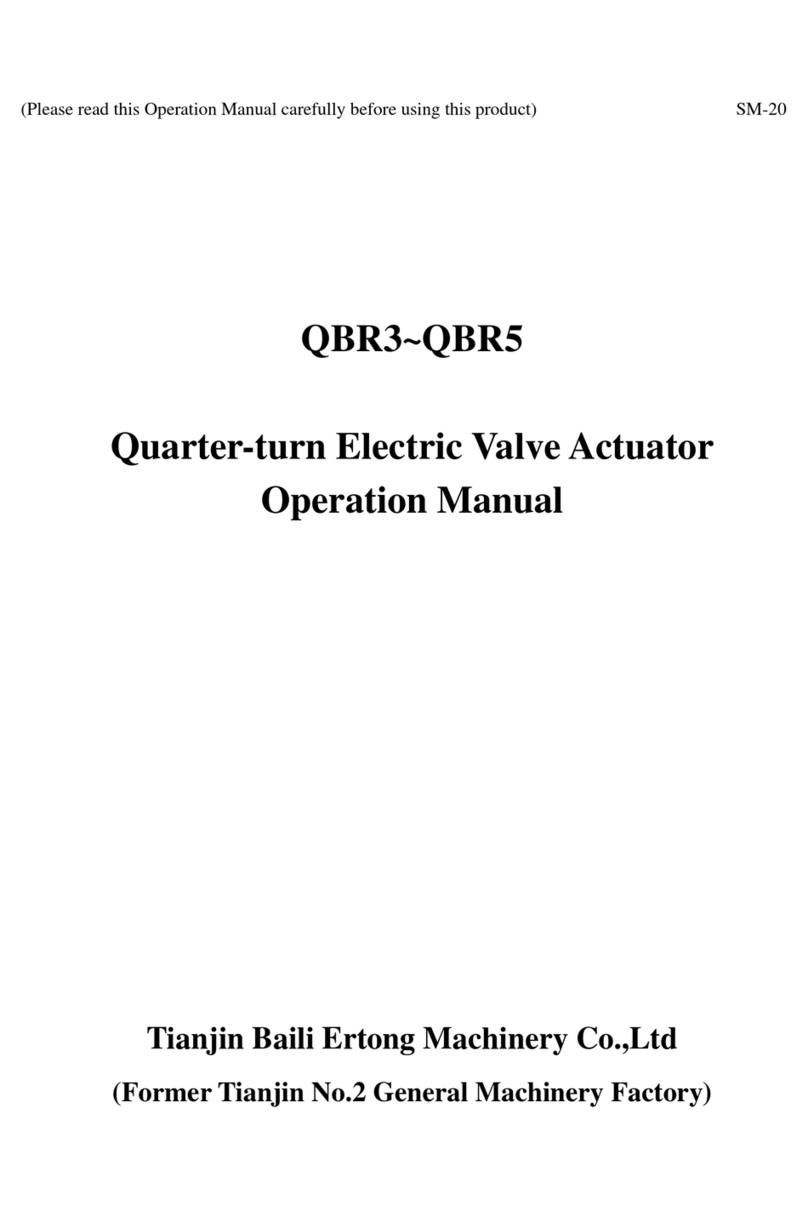
TIANJIN BAILI ERTONG MACHINERY
TIANJIN BAILI ERTONG MACHINERY QBR3 User manual
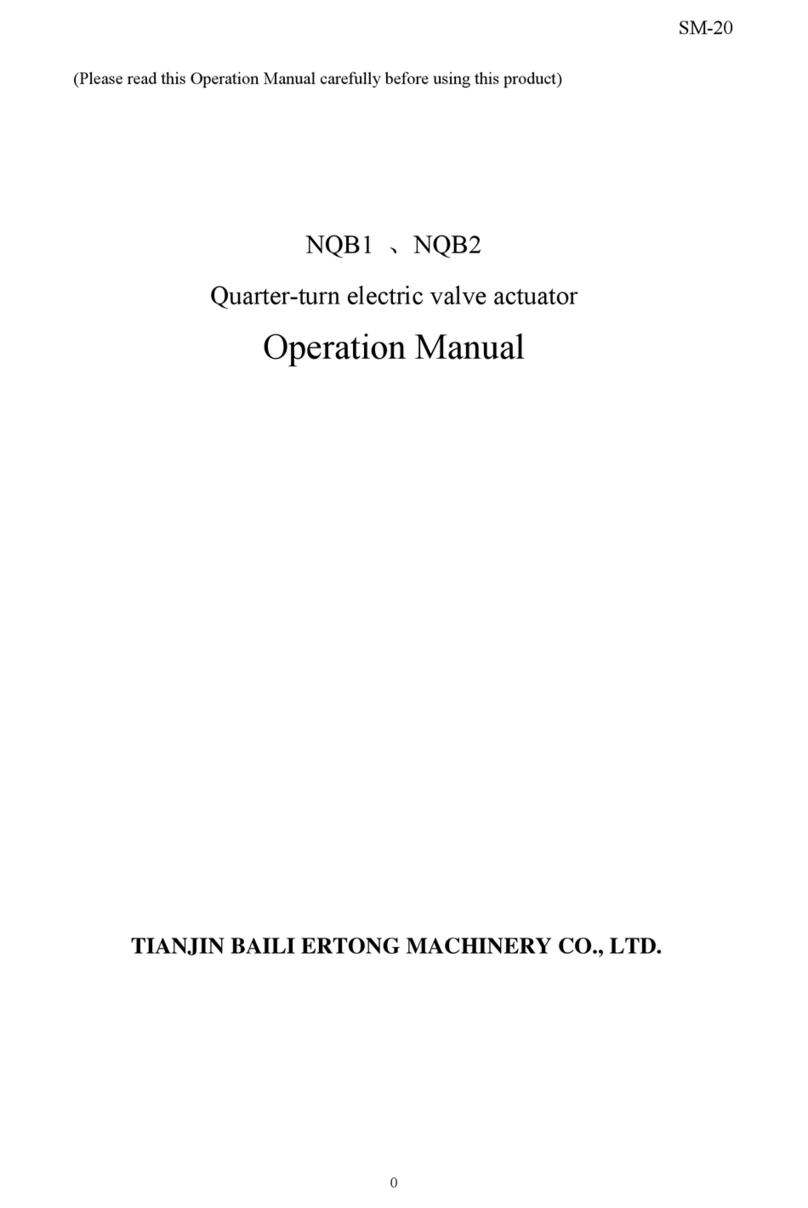
TIANJIN BAILI ERTONG MACHINERY
TIANJIN BAILI ERTONG MACHINERY NQB1 User manual

TIANJIN BAILI ERTONG MACHINERY
TIANJIN BAILI ERTONG MACHINERY XZA Series User manual

TIANJIN BAILI ERTONG MACHINERY
TIANJIN BAILI ERTONG MACHINERY SMC Series User manual
Popular Controllers manuals by other brands
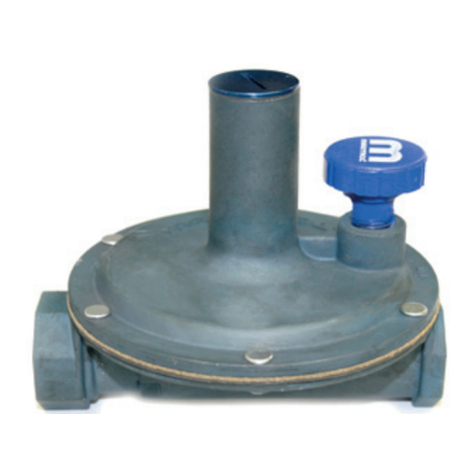
Maxitrol
Maxitrol 325 Series manual
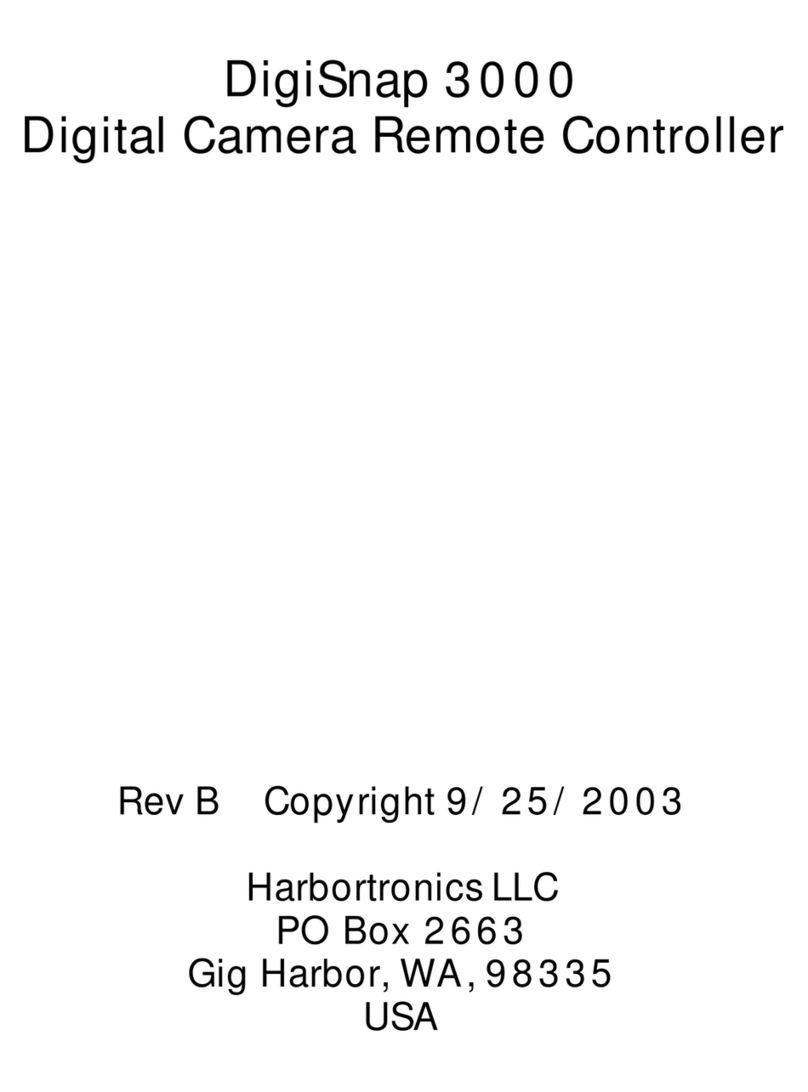
Harbortronics
Harbortronics DigiSnap 3000 user manual

SMC Networks
SMC Networks ISA3-FCP-4LB-L1 Operation manual
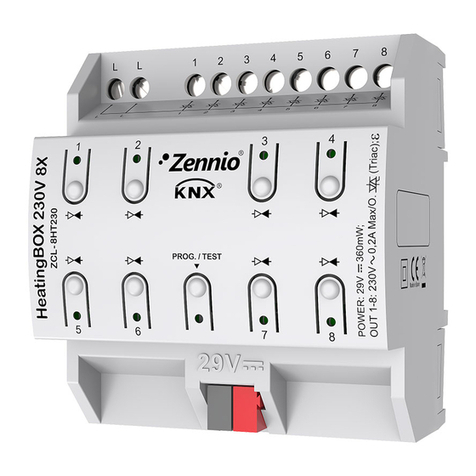
Zennio
Zennio HeatingBOX 24V 4X user manual
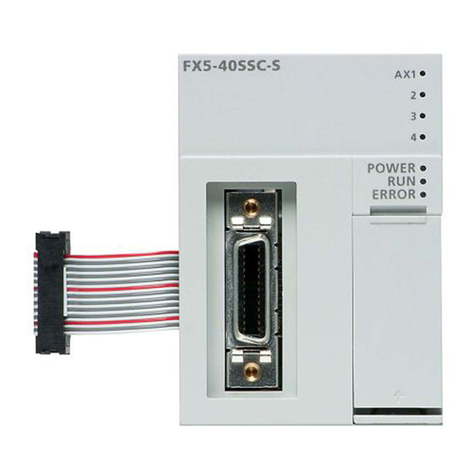
Mitsubishi Electric
Mitsubishi Electric MELSEC iQ-F FX5 user manual
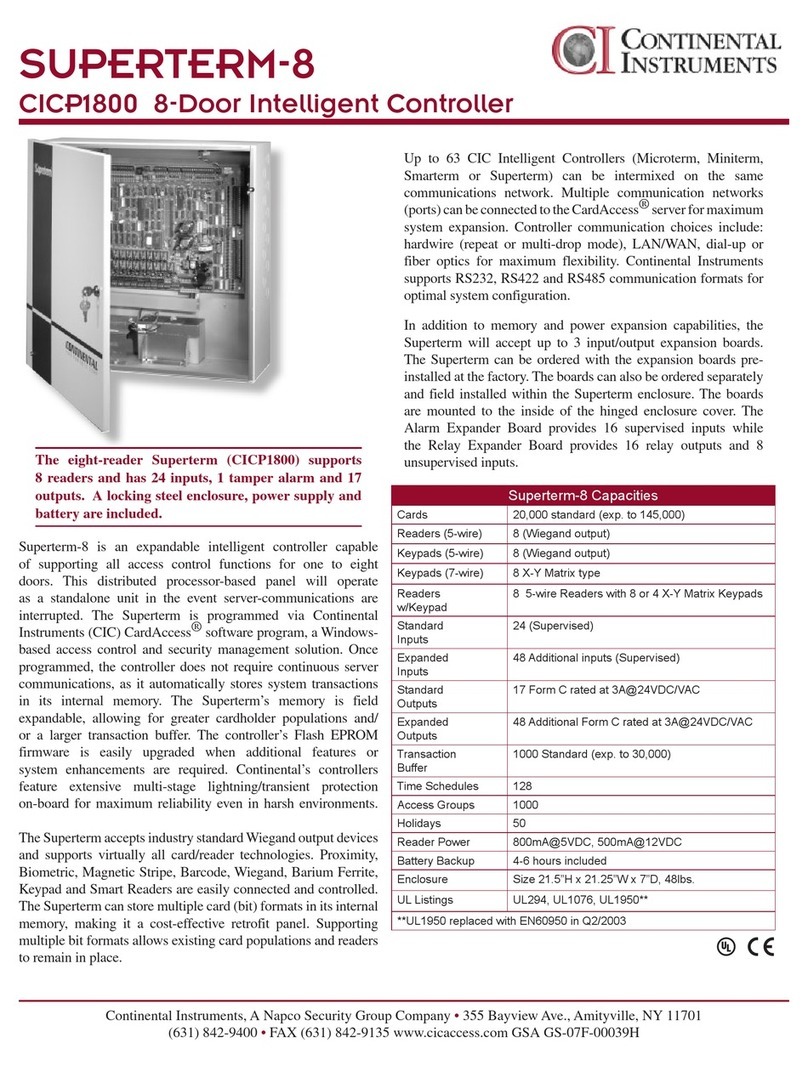
Continental Instruments
Continental Instruments CICP1800 datasheet
